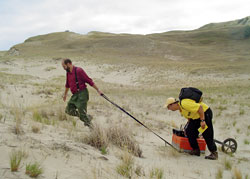 |
 Enlarge image
Enlarge image |
| Ilya Buynevich, right, with Lithuanian colleague Albertas Bitinas use ground-penetrating radar to map ancient surfaces beneath Baltic Sea dunes, to understand patterns of climate change in Europe. |
The dunes along the Baltic Sea coast are telling a story.
It’s a tale of shifting winds, moving shorelines, and
buried fishing villages. Massive mounds of sand are describing
6,000 years of climate change in Europe and perhaps around
the world. Coastal geologist Ilya Buynevich is listening.
With sediment samplers and ground-penetrating radar (GPR),
Buynevich (right) and Lithuanian colleague Albertas Bitinas
(left) are reconstructing the history of the dunes. They are
looking for “paleosols”—old soils buried
under sand. These layers sometimes poke out as blackened ridgelines.
More often, Buynevich and Bitinas find them with GPR signals
that pierce the earth and reflect the past (they show up as
darker, diagonal lines stretching to the surface in the subterranean
map below).
Paleosols reveal the old land surface before wind-blown sands
buried it. Bits of wood, pollen, charcoal, and shells can
be dated through radiocarbon techniques; adjacent sands can
be dated through optically stimulated luminescence. These
geologic archives tell Buynevich about the strength and prevailing
direction of Baltic winds at various times, and the climate
conditions that caused them. When winds are calm, dunes stabilize
and soil and settlements take hold. When winds are fierce
and forest fires bare the landscape, dunes move landward,
burying the soil and the man-made structures on it. Dating
the border between these horizons tells Buynevich when the
region’s climate changed from warm and stable to cold
and stormy.
For thousands of years, castles and villages grew up behind
the dunes, protected from the relentless Baltic winds. At
least 12 villages were ultimately buried. Buynevich and Bitinas
hope to find those bits of human history that reflect natural
history.
Buynevich is also studying dunes in Aquinnah on Martha’s
Vineyard, where conditions are similar. He’s keeping
an eye on research in Australia to see if the dunes are moving
in synch with those in Lithuania and Aquinnah—a telltale
sign of global climate changes.
—Mike Carlowicz
 A section of the subsurface, made from ground-penetrating radar signals, show old soil layers buried by the moving sands.
A section of the subsurface, made from ground-penetrating radar signals, show old soil layers buried by the moving sands.
» View more
highlights for the Geology and Geophysics Department
|

